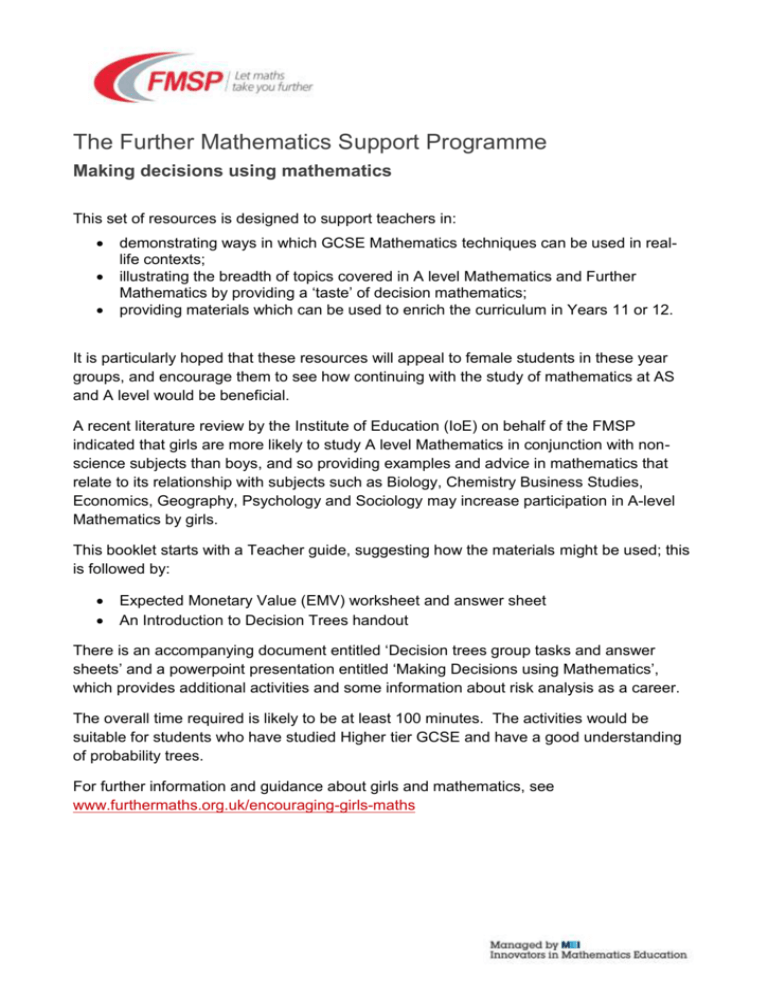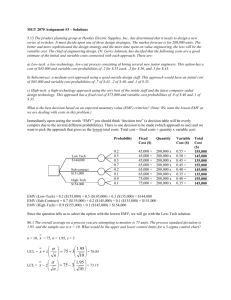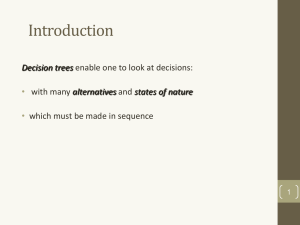Decision Trees Teacher Guide - The Further Mathematics Support
advertisement

The Further Mathematics Support Programme Making decisions using mathematics This set of resources is designed to support teachers in: demonstrating ways in which GCSE Mathematics techniques can be used in reallife contexts; illustrating the breadth of topics covered in A level Mathematics and Further Mathematics by providing a ‘taste’ of decision mathematics; providing materials which can be used to enrich the curriculum in Years 11 or 12. It is particularly hoped that these resources will appeal to female students in these year groups, and encourage them to see how continuing with the study of mathematics at AS and A level would be beneficial. A recent literature review by the Institute of Education (IoE) on behalf of the FMSP indicated that girls are more likely to study A level Mathematics in conjunction with nonscience subjects than boys, and so providing examples and advice in mathematics that relate to its relationship with subjects such as Biology, Chemistry Business Studies, Economics, Geography, Psychology and Sociology may increase participation in A-level Mathematics by girls. This booklet starts with a Teacher guide, suggesting how the materials might be used; this is followed by: Expected Monetary Value (EMV) worksheet and answer sheet An Introduction to Decision Trees handout There is an accompanying document entitled ‘Decision trees group tasks and answer sheets’ and a powerpoint presentation entitled ‘Making Decisions using Mathematics’, which provides additional activities and some information about risk analysis as a career. The overall time required is likely to be at least 100 minutes. The activities would be suitable for students who have studied Higher tier GCSE and have a good understanding of probability trees. For further information and guidance about girls and mathematics, see www.furthermaths.org.uk/encouraging-girls-maths Teacher Guide Time Activity Resources 10 mins Slide 2: Introduce the idea of decision making using mathematics rather than just human judgement. PPT What sort of real-life scenarios might this be helpful for? e.g. business decision making, deciding whether to enter the national lottery, deciding whether to play a particular game, analysing chances of winning in sporting competitions, etc…. Slide 3: Some examples of ‘key questions’ that the techniques in today’s lesson might answer. Invite students to identify aspects of the given scenarios relating to ‘chance’. 15 mins PPT Deepwater drilling rigs can cost around $420,000 per day – is it worth building the rig? How long will the rig produce oil? Is it worth the costs of drilling? How many possible combinations are there in the national lottery draw? What is the chance of winning? What is the expected win? Dice games – if you had to pay compete in a dice game and win only if certain scores are obtained, how would you know whether to play or not? Investment – if you have the opportunity to invest in a business partnership for a new business, what would you need to find out more details about? What is the degree of risk? What might you expect to gain or lose in the first year? The organiser of a sports competition might take out insurance against poor weather which prevents play – this is called pluvius insurance or abandonment insurance Slide 4: This is an aside to the main topic of the lesson, but it is an interesting and relevant aspect to look at briefly, if time allows. Introduce students to some basic investigation of the lottery scenario e.g. If there are 4 balls labelled 1 – 4, how many ways could two balls be chosen? What is there were 5 balls and 2 were chosen? Working this out individually is very time consuming for picking 6 balls from 49. Introduce the nCr button and how this ties in to the investigation. Now students can find that the number of combinations is 49C6 = 13, 983, 816 and so the chance of winning is around 1 in 14 million. PPT Calculators Time Activity Resources 15 mins Distribute copies of the EMV handout (page 4 of this booklet) EMV Handout Slides 5 and 6: Introduce the idea of calculating expected monetary value (EMV). Discuss how EMV can give a value for a ‘risk’ (financial loss) or for a ‘reward’(financial gain). PPT Ask students to work in pairs or small groups to consider the questions on the EMV handout. After a few minutes of considering the questions, review as a group: 20 mins Which of these outcomes are risks and which are rewards? Which has the highest expected monetary value? Which has the lowest expected monetary value? If all of the outcomes listed occur, would they represent a total loss or a total gain? Answers are provided on an EMV handout including answers (see page 5 of this booklet). EMV Handout Answers Distribute copies of the Introduction to Decision Trees handout (page 6 of this booklet). Introduction to Decision Trees handout Slides 7 - 11 : Explain the symbols used in decision trees and sketch on the board how these would be positioned on a tree. Slides 8 and 9 show a simple example of how to use a decision tree – work through this example to illustrate the way a tree is constructed and state the need to work backwards to do calculations. Now introduce the Dice Game outlined on slide 10 and encourage students to sketch a decision tree, perhaps on a mini whiteboard so amends can be made. Depending on the group, either allow some time for pairs of students to draft their own decision tree, or for students who are less secure with the ideas, go through the production of the decision tree as a whole group. When reviewing the calculations, discuss the importance of each of the symbols. It is vital to work BACKWARDS when carrying out calculations, which students might find unnatural as they will be used to doing probability tree diagrams working from left to right. The answer is shown on page 7 of this booklet and is illustrated step by step on slide 11. PPT Time Activity Resources 30 mins or longer if time allows After reviewing the Dice Game, pairs of students could either pick their own choice of task from the Decision Trees Groups Tasks handout or tasks could be allocated by ability (Tasks C and D are the most demanding). Decision Trees Group Tasks Handout Bring the group back together to discuss the tasks after they have completed one (or more, depending on time available), or circulate around the pairs of students to check answers. If planning to discuss as a group, give students A3 paper to produce their decision tree on so that they can be displayed to the class. 10 mins Slides 12 - 14: Finish the session give students an overview of the role of risk analysis in business and as a career. Further information can be found at: http://www.prospects.ac.uk/financial_risk_analyst_job_description. htm or http://www.theirm.org/ Close by signposting the FMSP website to students, where further information about maths careers and the promotion of A level Mathematics and Further Mathematics can be found. PPT The Further Mathematics Support Programme Making decisions using mathematics Expected Monetary Value (EMV) An Expected Monetary Value (EMV) calculation is used to quantify the monetary risk or reward of a particular outcome. EMV = (probability of outcome) x (cost of outcome) Consider the following risks and rewards associated with a large building project. Weather There is a 20% chance of excessive snow which would cause a delay of approximately 2 weeks which would cost £80,000. Construction Materials There is a 10% probability of the price of construction material dropping, which will save the project £90,000. Workers going on strike There is a 5% probability of construction coming to a halt if the workers go on strike. The impact would cause additional costs of £150,000. Planning permission There is a chance of 5% that the planning permission required will be returned 3 weeks earlier than expected, which would create a saving of £115,000. Which of these outcomes are risks and which are rewards? Which has the highest expected monetary value? Which has the lowest expected monetary value? If all of the outcomes listed occur, would they represent a total loss or a total gain? Activity adapted from http://www.brighthubpm.com/risk-management/48245-calculating-expected-monetary-value-emv/ The Further Mathematics Support Programme Making decisions using mathematics Expected Monetary Value (EMV) - Solutions Weather There is a 20% chance of excessive snow which would cause a delay of approximately 2 weeks which would cost £80,000. EMV = 0.2 x -£80,000 = -£16,000 Construction Materials There is a 10% probability of the price of construction material dropping, which will save the project £90,000. EMV = 0.1 x £90,000 = £9,000 Workers going on strike There is a 5% probability of construction coming to a halt if the workers go on strike. The impact would cause additional costs of £150,000. EMV = 0.05 x -£150,000 =- £7,500 Planning permission There is a chance of 15% that the planning permission required will be returned 3 weeks earlier than expected, which would create a saving of £115,000. EMV = 0.15 x £115,000 = £17,250 Which of these outcomes are risks and which are rewards? Weather and workers striking are risks; the other two bring possible rewards. Which has the highest expected monetary value? The planning permission at £17,250 Which has the lowest expected monetary value? The weather at -£16,000 (i.e. a £16,000 loss) If all of the outcomes listed occur, would they represent a total loss or a total gain? £17,250 + £9,000 - £16,000 - £7,500 = £2,750 so a total gain (as the value is positive). Activity adapted from http://www.brighthubpm.com/risk-management/48245-calculating-expected-monetary-value-emv/ The Further Mathematics Support Programme Making decisions using mathematics An Introduction to Decision Trees A decision tree is used to show possible risks and rewards in a given scenario and thereby calculate the best overall course of action. It looks a bit like a tree diagram, but also incorporates the following symbols which are placed at the end of branches: Decision node Chance node End node Work in pairs to construct a decision tree for the following Dice Game. See if you can work out the EMV for each stage of the game, and hence work out the overall EMV. What would you recommend? Would you play the game? If you get a 5 or a 6, should you roll again? In a game you are asked by the Gamekeeper to roll a fair dice. If a 5 or a 6 is obtained, the Gamekeeper will pay you £20. For any other number you have to pay the Gamekeeper £5. However, in the second case, instead of paying £5 straight away you can opt to roll the dice again. If you roll again and score a 6, the Gamekeeper will pay you £35. Otherwise you lose a further £5 and so you will need pay £10 in total. An Introduction to Decision Trees - Solution The Dice Game In a game you are asked by the Gamekeeper to roll a fair dice. If a 5 or a 6 is obtained, the Gamekeeper will pay you £20. For any other number you have to pay the Gamekeeper £5. However, in the second case, instead of paying £5 straight away you can opt to roll the dice again. If you roll again and score a 6, the Gamekeeper will pay you £35. Otherwise you lose a further £5 and so you will need pay £10 in total. Roll a 6 1 5 ( × £35) + ( × −£10) 6 6 Probability £35 1 6 -£2.50 Roll again - £10 Roll 1 - 5 -£2.50 Probability 5 6 1 – 4 scored 2 Probability 3 Don’t roll again -£5 £5 Play the game 5 or 6 scored £20 1 Probability 3 Don’t play the game £0 Work backwards from right to left, calculating the EMV for each decision or chance node. Place a double line across rejected decisions. The best strategy for this game is: Play the game, with overall EMV of £5. If a 1-4 is scored, the best strategy is to roll again as this has a better EMV than not rolling again.




